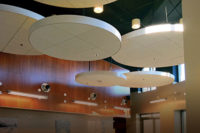PROJECT 1
Risen Savior Lutheran Church in Basehor, Kansas is a remarkably solid, traditional and old-looking brand-new building. Mark Curfman of Urban Architecture Studio and Jerry Frese of J.M. Frese Construction worked in concert to create a very traditional church within a tight budget using structural insulated panels.
“We wanted to design and build a church that reflected both the traditions of the Lutheran Church of 500 years ago and the Risen Savior Lutheran Church congregation in rural Leavenworth, Kan., and do it with today’s construction and materials,” says Curfman. “We looked at the elements that make up a Lutheran church and the ideas that went into the design and construction of the original churches.”
“From ancient times, it was believed that the world has a geometric order and to understand this geometry was to understand the creator—God. This geometry became the backbone for much of the sacred art and architecture from ancient times forward. We used these principles of sacred geometry in the design.
“Risen Savior’s wood trusses incorporate a Gothic arch and help to focus on the arched Apse and ultimately the Altar,” Curfman explains. We wanted this rich material and craftsmanship to carry throughout the church—not like many contemporary churches that are just acres of drywall. The congregation wanted a church that looked from day one like it had been there for 100 years.”
Gothic arches and rich wood trusses give the appearance that the church has rested solidly here for many years.
According to Curfman, R-Control SIPs were chosen for the roof because of the desire to maximize roof insulation R-value and speed up enclosure of the finished trusses.
“We wanted to make the church as energy-efficient as possible to minimize the annual operating expenses for the church,” he says. “We also wanted to protect our lofty investment in the trusses. A slow roof installation could be devastating to the project, with the outside elements putting the exposed trusses at risk.
“The trusses were to be stained and a finished element in the building. The last thing we needed was for weather to destroy the beautiful craftsmanship of the trusses,” Curfman continues. “Once we had the trusses erected, the SIPs were laid in less than two weeks and the trusses were protected. The SIPs were perfect for this project.”
THE BEAUTY OF HOW IT FITS
Chris Orlando, PE, of CEO Structural Engineers, whose team was responsible for designing the building structure says, “SIPs work really well for wood-framed roofs because of the way the long edges connect. No matter what the roof pitch is, typical roof construction starts by spanning each SIP from one sloped truss across to the next. Then long threaded screws on regular centers are drilled through the SIP that cinches each bearing end down tightly onto the truss substructure, which also prevents the SIP from sliding.”
“Now, here’s the beauty,” Orlando says. “Along one side, the 2x8 is fitted into the recess and panel-nailed from both faces, then another 2x8 is fitted onto the first and nailed together, then the recess of the next SIP fits over the second 2x8 and panel-nailed from both faces. In this way all four edges of each SIP panel are connected, creating a sturdy diaphragm that not only takes weight, but also can transfer lateral loads to shear walls or resisting frames.”
Orlando remembers there was a lot of cooperation. “A good result happens when everybody is part of the solution. ACH Foam Technologies, the SIPs manufacturer, started off providing standard generic details that we saw had to be modified due to the exceptionally steep roof pitch that created problems for how flat SIPS came together at peaks and valleys. On the theme that all four edges of each SIP are to be connected, we were impressed with ACH’s willingness to complete the details to our requirements and then construct them with a caliber of craftsmanship that matches the significance of the building.
“Just to make sure it was going to turn out right, we modeled the entire roof structure in 3-D CAD using Google Sketch-Up, showing in precise detail how all the angles should be cut,” he says. ACH followed every detail precisely, which made the overall placement of the SIPs virtually flawless. One reason the building looks as good as it does is because the SIPs were erected and set very, very well.”
PROJECT 2
Public housing rarely gets the attention of the USGBC but Oz Qureshi wants to change that. As construction manager for the Kansas City Housing Authority’s YouthBuild program, Oz decided to make this single family home a standout example of how green building can benefit all stakeholders: the resident family, at-risk-youth who had the opportunity to build it, the taxpayers, and the environment.
“Lack of affordable housing is a social issue we can’t control,” says Qureshi. “But a poorly insulated home is something we can address. We wanted to demonstrate that, even with public housing, you can build as green as you want to go. And greener public housing helps to solve other contingent problems.”
According to Qureshi, there is so much lumber filling a stick-framed project you can hardly move around when plumbing and lining the walls. “SIPs made the job much faster and easier because none of that extra bracing was needed.”
Oz explains another reason for using SIPs for the home. Sixty at-risk youth trainees worked alongside two experienced trainers in the construction of the home.
YouthBuild is a youth and community development program that teaches at-risk youth construction trades and offers them three nationally recognized construction certifications and helps them obtain their GED.
“We personally requested the architects use SIPs for this project,” says Qureshi, “not only because we wanted a tight energy-efficient envelope—but also because the SIPs can be installed much faster than other building techniques. This is a huge advantage to a construction training program. We were under roof in just two weeks.”
According to Qureshi, it would have taken seven weeks to stick frame the home.
PROJECT 3
Mike Gibson of Murray & Sons Construction was the contractor on the Manhattan, Kansas Firestations 3 and 5. He appreciates that the owner and architect on the project had the foresight to specify SIPs for what he calls a “flagship community building”.
“This is as cool a design as we’ve ever seen,” Gibson quips. “People often have a pre-conceived notion of what a SIPs building looks like. What’s super cool about this is that, unless you know that SIPs were used to build the firestation, you would have no idea by looking at the finished design that it was constructed with pre-fabricated panels.”
Gibson also thinks that taxpayers will appreciate the SIPs construction. “You have an entire bank of taxpayers who are saving money over the next 50-year life cycle of this firestation, because of the superior energy efficiency of the SIPs,” Gibson adds. “Often SIPs are reserved for residential construction. In the case of the Manhattan firestation, people were thinking outside the box. Bringing SIPs into the public sphere should make a whole lot of taxpayers happy.”
According to architect Tracy Anderson, the city wanted its firestation to represent the city’s commitment to sustainable building. “We had used SIPs before and we knew that SIPs would allow us to create the tightest building envelope possible,” says Anderson. “Also, the alternative nature of SIPs was compatible with the geothermal heating and cooling system that was being installed.
“We used SIPs for the entire building envelope—the walls as well as the roof. It worked out great, even though it was not a simple building. There were some complex rooflines.
According to Anderson, SIPs minimized the roof structure, saving time and money. “The mechanical room ended up in the attic area,” he explains. “Normally an attic would not be insulated at the roofline, but typically at the ceiling plane. Because we roofed the station with SIPs, it is so well insulated that we don’t have to worry about stressing the HVAC equipment due to extreme temperature swings.”
Gibson says that the energy efficiency of a SIPs building spills over to the contractor: “We all know that over the life span of a SIPs building, the owner reaps substantial energy savings. What we did not expect was a residual benefit. During the final stages of construction, when the temporary heating and cooling is on our dime, we save money because the envelope is so snug.”











